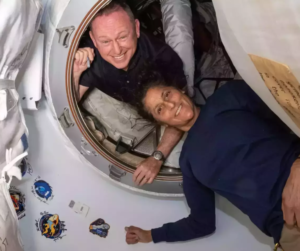The prolonged stay of NASA astronauts Sunita “Suni” Williams and Barry “Butch” Wilmore aboard the International Space Station (ISS) has brought to light significant concerns regarding the health implications of extended space missions. Originally scheduled for a brief eight-day mission in June 2024, their return has been delayed due to technical issues with the Boeing Starliner spacecraft, extending their stay to over eight months. This unexpected extension underscores the profound physiological challenges astronauts face during prolonged exposure to microgravity environments.
Bone Density Loss and Muscle Atrophy
In microgravity, the human musculoskeletal system undergoes rapid degeneration. Bones, no longer subjected to Earth’s gravitational forces, experience accelerated density loss. Kyle Zagrodzky, founder and CEO of OsteoStrong, highlights that astronauts endure bone density reduction at a rate approximately 12 times faster than severe osteoporosis on Earth. This rapid decline significantly elevates the risk of fractures, particularly in weight-bearing bones like the hips, which can lead to life-altering injuries. Concurrently, the absence of gravitational load results in muscle atrophy, compromising strength and endurance. The European Space Agency notes that astronauts can lose up to 50% of their muscle mass during extended missions, affecting their ability to perform physically demanding tasks both in space and upon return to Earth.
Cardiovascular and Neurological Impacts
The cardiovascular system also adapts detrimentally to prolonged weightlessness. The heart, operating with reduced workload, can undergo morphological changes, shifting from its typical oval shape to a more spherical form. This transformation may impair cardiac function over time. Additionally, the redistribution of bodily fluids toward the upper body in microgravity can lead to increased intracranial pressure, potentially causing vision problems and cognitive impairments. Some astronauts report experiencing “space fog,” a condition characterized by disorientation, nausea, and mood swings, which can hinder mission performance and safety.
Radiation Exposure
Beyond the challenges posed by microgravity, astronauts are exposed to heightened levels of cosmic radiation. Despite the ISS’s protective shielding, crew members receive approximately 365 times more radiation than on Earth. This exposure accumulates over time, increasing the potential for long-term health issues, including a higher risk of cancer. The extended mission of Williams and Wilmore amplifies these concerns, as each additional day in space compounds their radiation exposure.
Mitigation Strategies and Ongoing Research
To combat these adverse effects, the ISS is equipped with specialized exercise equipment designed to simulate weight-bearing activities, helping to maintain bone density and muscle mass. Astronauts engage in rigorous daily exercise regimens, dedicating approximately two hours to activities such as resistance training and cardiovascular workouts. However, while exercise mitigates some negative effects, it does not fully counteract the physiological changes induced by prolonged microgravity exposure.
The situation faced by Williams and Wilmore underscores the necessity for continued research into effective countermeasures for long-duration spaceflight. Understanding the full spectrum of health risks is crucial, especially as space agencies plan for future missions to Mars and beyond, where astronauts will face even longer periods away from Earth’s gravity and protective atmosphere.
In conclusion, the extended mission of these astronauts highlights the pressing need to address the health challenges associated with prolonged space travel. Developing comprehensive strategies to mitigate bone and muscle loss, cardiovascular deconditioning, neurological effects, and radiation exposure is essential to ensure the safety and well-being of astronauts on future deep space missions.


